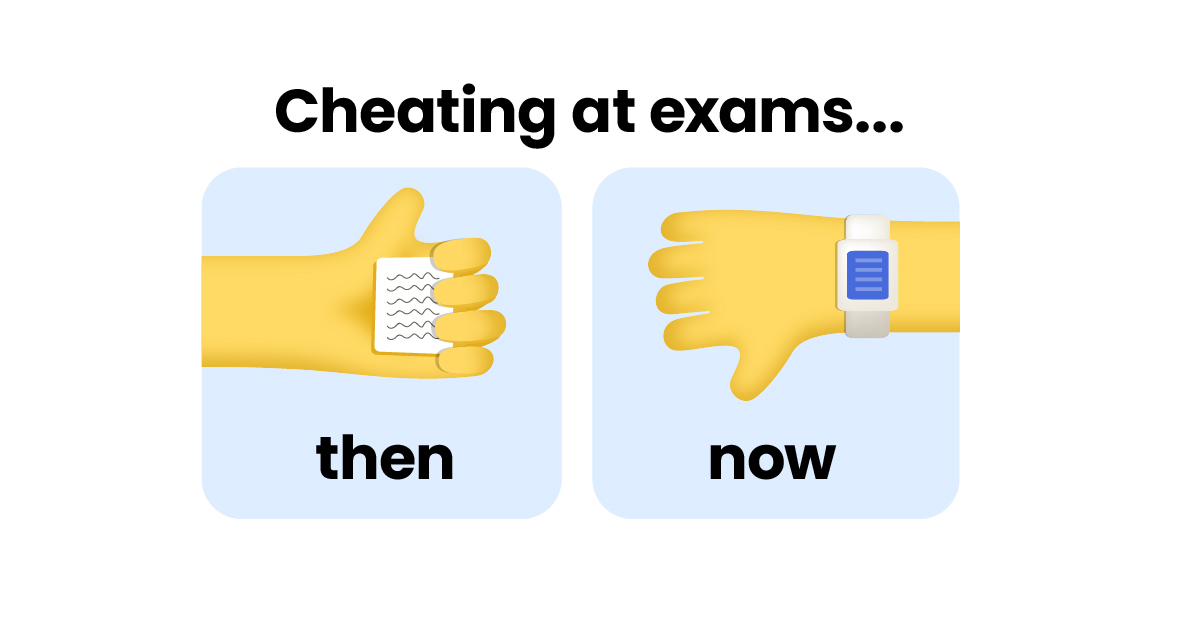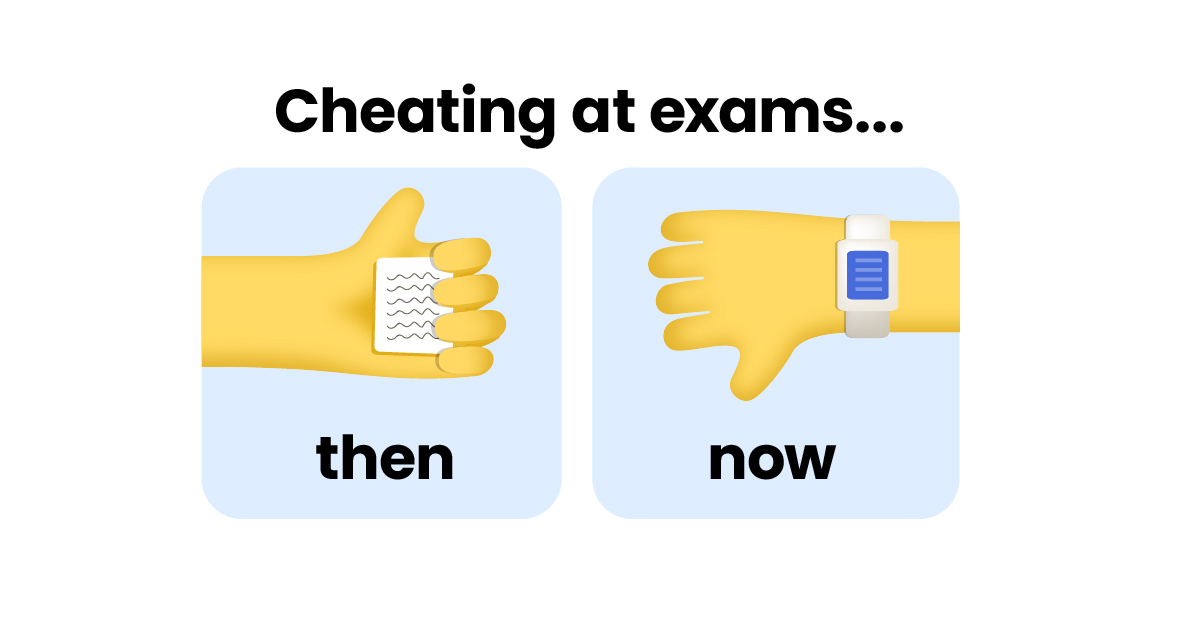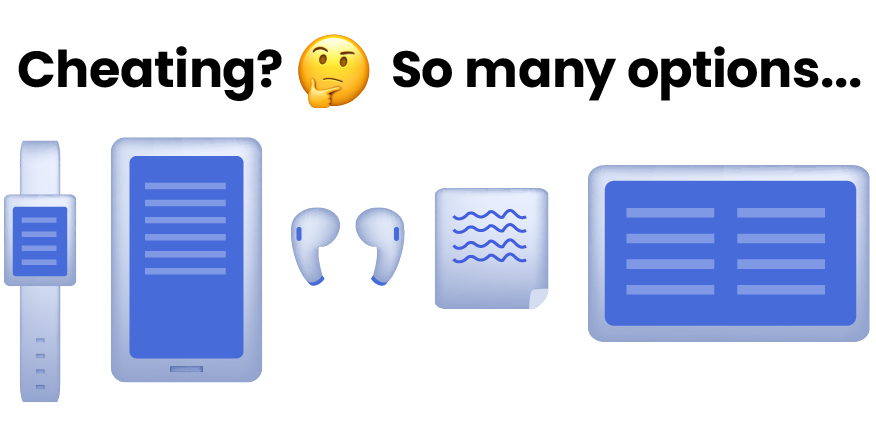
Cheating is not new!
Apr 3, 2023 11:59:21 AM
Cheating in exams is not a new concept, and for thousands of years students have found ways to cheat exams to gain an unfair advantage. In fact, students in ancient Greece were known to use their own bodies to smuggle notes into exams, with ancient Chinese students using bamboo sticks to carve answers into their nails. There are even records stating that a Chinese emperor once bribed the examiners to pass his son, so that he could join the civil service during the time of imperial examinations.
Today, students have access to devices, technology and software that can all be used to create sophisticated ways to cheat, which is creating a significant challenge for schools, colleges, and universities around the world. In our latest blog post, we explore the history of cheating in exams and how the digital age is adding to the complexity, especially within ‘Bring Your Own Device’ (BYOD) situations.
Cheating in exams is not a new concept
From the imperial examinations of the Chinese Sui dynasty (581-618AD) which continued until the Ming dynasty (1368-1644AD), through to the trivium and quadrivium exams that were administered by the Catholic Church in the Middle Ages, it is clear that high stakes exams have always been a target for cheating.

From ancient China to ancient Greece, cheating is an issue which has dominated exams for thousands of years, even the Romans were known to smuggle notes into exams using wax tablets! As we move through the centuries, there are a significant number of records that report students being caught cheating with hidden notes, copying from friends, and even trying to steal copies of exam papers.
Within traditional written exams using a pen and paper, the methods used by students to cheat have changed very little, with the following still being some common examples today:
- Collaboration – Students can work with peers to pass notes, whispers, or hand signals to each other during exams with shared questions. This is particularly effective if students are sat in close proximity, which may even allow students to copy from each other.
- Hidden materials – Students can smuggle notes into an exam, with popular options being writing on pieces of paper, body parts, on the back of a calculator or even inside a water bottle. Only a small space is needed to write formulas and key points which can be used to answer difficult questions.
- Cheat sheets – These are a more organised form of written notes, with students attempting to write key details such as formulas and definitions which are likely to be tested during the exam.
- Impersonation – Students can use another person to sit their exam, which although being more complex can be effective if undiscovered.
Over the years, teachers, headteachers, exam boards and invigilators have developed techniques to overcome many of these cheating methods, such as random seating, monitoring of the room and banning devices. As technology advances, it is even possible to use software such as facial recognition scanning to ensure the correct person is actually sitting the exam. Although technology can be used to prevent cheating, there are also students who are finding new ways to utilise these advances to cheat.
Cheating in the digital age
Despite cheating being an issue for thousands of years, with the progress of technology in our digital age, cheating has become even more widespread and complex. With students able to access the internet and store notes electronically, it is easier than ever to find answers during an exam, especially as small smartphones and smartwatches can be smuggled into an exam. In addition, with tablets, devices and laptops being used by students to complete examinations, the complexity of BYOD devices is presenting significant challenges.

The following are some examples of various methods used to cheat with technology:
- BYOD devices – Many schools and universities allow students to bring their own devices to exams, and while they are useful for completing the actual exam, students can access notes or stored study materials through their laptop, tablet, and smartphones.
- Internet – Students with access to the internet during an exam can quickly search for answers via websites or online resources. It is even possible that students may use an AI-powered platform to find complete answers to exam questions.
- Messaging apps – Students can use messaging apps such as WhatsApp and Messenger to communicate with each other during an exam. Many of these apps allow groups to be created, which could support students who are willing to work together to share answers.
- Remote access – There are tools available which allow devices to be accessed and controlled remotely, which would enable another person to take an exam on the student’s behalf.
- Hidden devices – Small devices such as mini cameras and earpieces could be used to receive external help within an exam setting. It is even possible to store notes within small devices such as smartwatches and calculators.
Overcome the challenges of cheating within digital exams
Despite schools implementing clear rules and consequences for cheating, there will still be students who will attempt to cheat. High-stake exams have been important to our society for thousands of years, and it is important to uphold academic integrity by implementing measures that seriously tackle cheating during this digital age.
As technology advances, it is important to monitor potential cheating methods and to implement strict control measures quickly. From blocking the internet to banning the use of student devices, there are a variety of potential options available. However, in many situations students actually need access to the internet and their devices to complete the exam, so more complex solutions are often required.
One of the most effective solutions to overcoming cheating in BYOD situations is to utilise secure browsers, which are designed to limit student’s access to external resources. There are many ways secure browsers can be utilised, such as:
- Locking down devices – Secure browsers can lockdown a devices access to other windows, tabs, and applications during an exam. This means students are unable to access tools such as the internet, stored notes, and messaging apps. Read about how a secure browser works and can be used
- Restricted browsing – Secure educational browsers can be used to restrict browsing, which will prevent students from accessing websites other than those approved for use during the exam.
- Anti-cheating features – These browsers can monitor student activity, prevent copy and paste functionality, and disable access to applications that may contain notes.
- Data encryption – By encrypting the data within exam questions and answers it prevents information from being intercepted and altered.
Helping institutions prevent cheating during the digital age
We understand that the use of technology within school exams may seem complex, but with our support it is possible to create effective cheating prevention measures which are simple to implement and manage. To find out more about balancing your investment in anti-cheating technology with the additional operational tasks, take a look at our article: BYOD exam, Balance between secure, Cost and operational complexity. Alternatively, book a call with a Nudge IT specialist today, and we will take you through the various options available.
Submit a comment